
MES system is a set of production information management system for the executive level of the manufacturing enterprise workshop.
MES can provide companies with manufacturing data management, planning and scheduling management, production scheduling management, inventory management, quality management, human resource management, work center/equipment management, tooling management, procurement management, cost management, production process control, bottom-level data integration analysis, upper-level data integration and decomposition, and other management module. In order to create a solid, reliable, comprehensive and feasible manufacturing collaborative management platform for the enterprise.
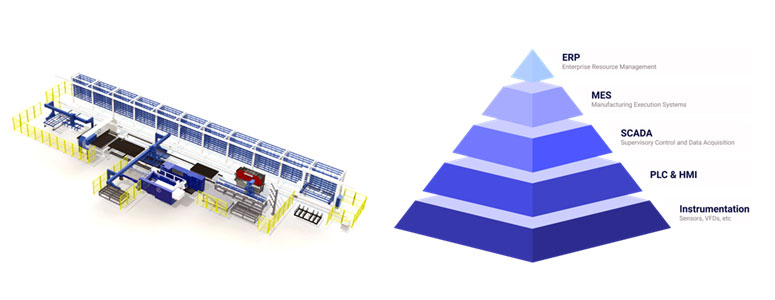
MES is Manufacturing Execution System. With the advent of “Made in China 2025”, the automation in industrial manufacturing will become higher and higher. The application of MES systems in sheet metal processing will become more and more extensive.
Companies realize that we need to enhance our competitiveness from the most basic production management, pay attention to the accuracy and timeliness of information, and standardize processes. Enterprises bring expected benefits.
MES has been widely used in sheet metal production line, and many enterprises have developed a keen interest in MES. How does it work in the sheet metal production?
It is mainly composed of a multi-sheet metal storage system unit, punching composite unit, laser cutting unit, and robot bending unit.
– Sheet metal storage system
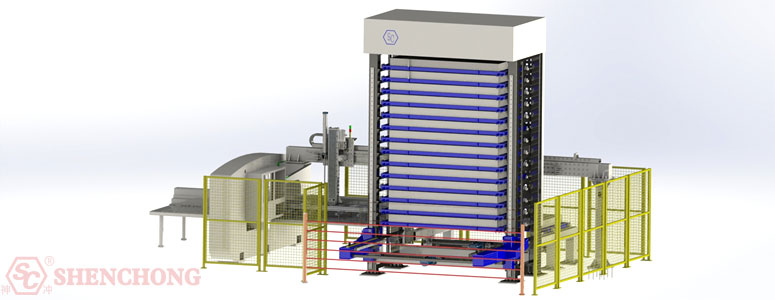
– Punching composite unit
The punching composite unit is mainly composed of feeding device, punching machine, right-angle shearing device, sorting device, palletizing device, etc.. The plates are taken out from the sheet metal storage system for stamping, forming, rolling, marking and other processes, and punching to each semi-finished part, the different parts are sorted and stacked by the palletizing device, and then stored on the shelf.
– Laser cutting unit
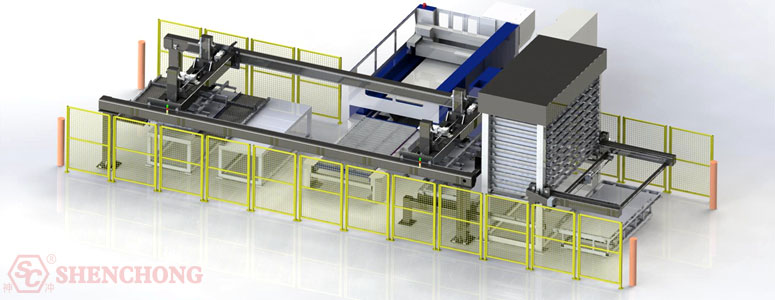
The laser cutting unit is mainly composed of a loading and unloading device, a laser cutting machine, an interactive workbench, etc.. The plates are taken out from the sheet metal storage system for cutting processing, sorted by the loading and unloading device, and then stored on the shelf.
– Robot bending unit
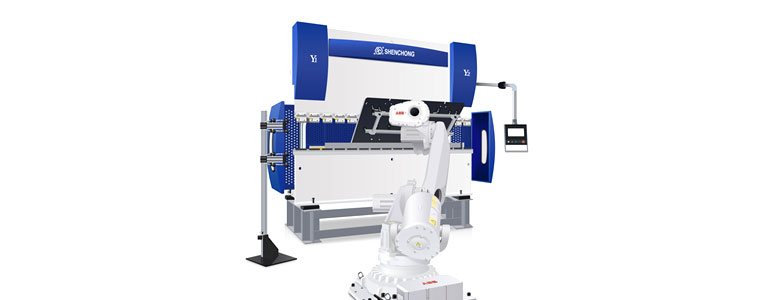
The robot bending unit is mainly composed of loading table, positioning table, turning frame, robot, robotic press brake, unloading table, etc. It is used to bend part of the parts processed by the punching composite unit/laser cutting unit into various semi-finished products required by customers, and manually transfer to the next process.
After the equipment receives the task signal, it will recognize the task. The recognition content is as follows:
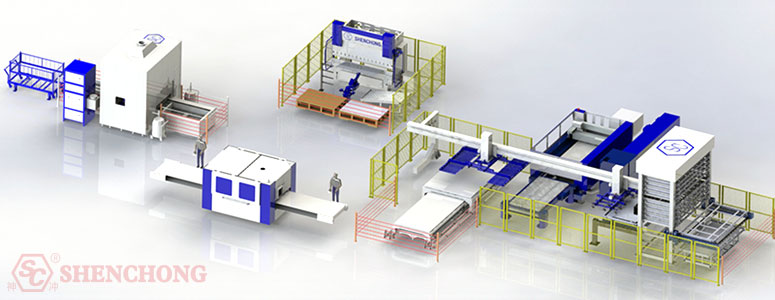
- Punching composite unit: Check whether the machine tool characteristics such as machine stroke and punching tonnage meet the requirements of the task. Check whether the punch die and the knife edge clearance of the shear are ready to be in place.
- Laser cutting unit: Check whether the cutting gas meets the requirements.
- Robot bending unit: Check whether the bending machine tools are correct for the work pieces.
After the equipment task self-recognition is completed, the recognition result will be feedback to the control system. For tasks that can be executed, it start processing immediately. For the recognized failed task, feedback the result to the control system and the reason for the task failure.
The punching and shearing compound unit, punching unit, laser cutting unit, and robot bending unit request materials from the sheet metal storage system according to the received task requirements.
Because the punching and shearing compound unit, punching unit, laser cutting unit, and robot bending unit are all provided with raw materials from multi-sheet metal storages.
Therefore, the multi-sheet metal storage system unit is based on the time sequence of the two request materials, If it is found that the raw materials are not available or the quantity is insufficient, feedback to the MES in time and prompt to add in time.
After the processing equipment transports the raw material plates from sheet metal storage, the processing task starts.
During the processing, the equipment update the processing information to the superior in real time, and at the same time refreshes the equipment status in real time.
What is MES in manufacturing? MES is “Manufacturing Execution System”. The MES system mainly controls the process.
Firstly, establish the operation plan, inspect the material, and the processing is scheduled when there is no shortage of materials. Assign the work plan to each device.
After the equipment sends a material request, the multi-sheet metal storage unit performs. After the distribution of materials is completed, the equipment will start production, and after the production is completed, an application for storage of semi-finished products, storage of materials, and work submission.
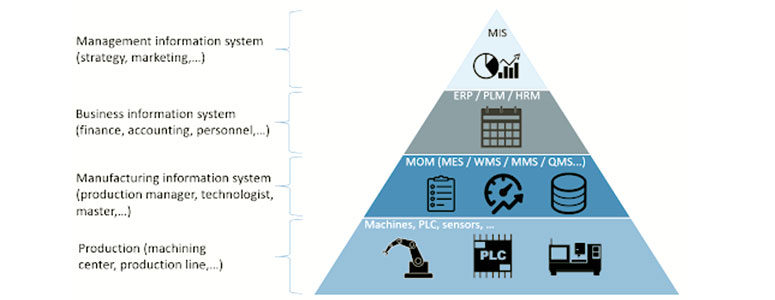
- When there is a user complaint, can you trace all the production process information according to the product text number? Can it be immediately identified: raw material suppliers, which machines, operators, which processes, production time and date, and key process parameters?
- When the same production line needs to assemble multiple models of products, can it automatically check and operate prompts to prevent worker component assembly errors, product production process errors, product mixing and product delivery errors?
- What are the top 5 product defects on the production line in the past 12 hours? What is the quantity of defective products?
- What is the quantity of each product in the warehouse and the pre-process, mid-process, and post-process lines? Which suppliers are to be supplied to? When can it be delivered in time?
- How much time does the production line and processing equipment have in production, and how much time are they stopped and idling? The main reason that affects the production potential of equipment is: equipment failure? Scheduling mistakes? Not timely supply of materials? Insufficient training of workers? Or is the process index unreasonable?
- Can the product quality inspection data be automatically counted and analyzed ? Accurately distinguish random fluctuations and abnormal fluctuations in product quality, and eliminate hidden quality hazards in the bud?
- Is it possible to abolish the manual report and automatically count the production quantity, pass rate and defect code of each process?
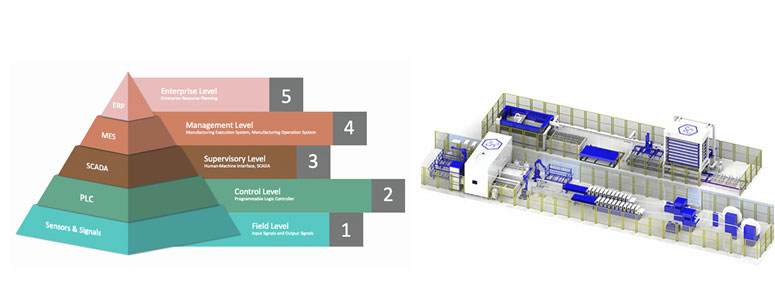
- Adopt the powerful data collection engine, integrated data collection channels (RFID, barcode equipment, PLC, Sensor, IPC, PC, etc.) to cover the entire factory manufacturing site, to ensure the real-time, accurate and comprehensive collection of massive field data.
- Build a basic platform for data collection of the factory production management system, with good scalability.
- Adopt advanced RFID, barcode and mobile computing technology, create a closed-loop barcode system from raw material supply, production, and sales logistics.
- Comprehensive and complete product tracking and tracing function.
- Production WIP status monitoring.
- Just-In-Time inventory management and Kanban management.
- Real-time, comprehensive and accurate performance and quality analysis SPC.
- Developed based on the Microsoft. NET platform, supporting mainstream databases such as Oracle/SQL Sever. The system is a combination of C/S structure and B/S structure, easy to install and easy to upgrade.
- The personalized factory information portal (Portal), through the WEB browser, can grasp the real-time information of the production site anytime and anywhere.
A strong MES technical team to ensure rapid implementation and reduce project risks.
- No need go to the workshop to control the production site conditions, process parameter monitoring, actual recording, and control
- Process quality management, problem retrospective analysis
- Material loss, ration tracking, inventory management
- Production scheduling management, reasonable arrangement of work orders
- Customer order tracking management, delivery on schedule
- If the production is abnormal, prompt the alarm in time
- Equipment maintenance management, automatic reminder maintenance
- Analysis of OEE indicators to improve equipment efficiency
- Automatic data collection, real-time, accurate and objective
- Reports are automatically generated in time, paperless
- Employee production tracking, objective assessment basis
- Quick cost calculation, order quotation decision
- Detailed cost management, budget execution analysis
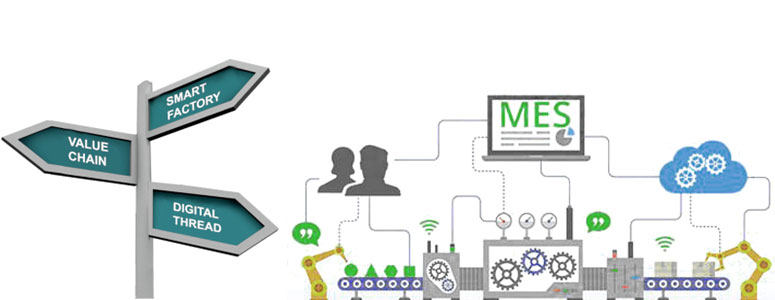
In recent years, with the introduction of new production modes such as JIT (Just In Time) and BTO (production-to-order). Customers and the market put forward higher requirements for product quality. MES has been rediscovered and received attention.
At the same time, after the collapse of the Internet economy bubble, companies realize that we must enhance our competitiveness from the most basic production management, that is, only take data information from the product level (basic automation level), pass through the operation control level, and send it to the management level. Realizing enterprise information integration through continuous information flow can make the enterprise invincible in the increasingly fierce competition.
MES is quickly and widely used in sheet metal production. Manufacturing Execution System (MES) aims to improve the execution capabilities of enterprises, and has irreplaceable functions.
Process industry enterprises in a competitive environment should distinguish the goals and functions of different manufacturing management systems, clarify the positioning of MES in the integrated system, and attach importance to accurate and timely information, standardized processes, tools, management innovation.
Analysis of its own execution capabilities according to the MES maturity model. Step-by-step implementation of the MES system in accordance with the three stages of information integration, transaction processing, and manufacturing intelligence, which can make full use of enterprise informatization. In order to improves the competitiveness of enterprises and brings expected benefits to enterprises.